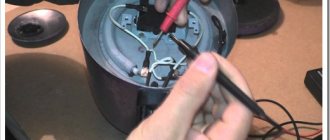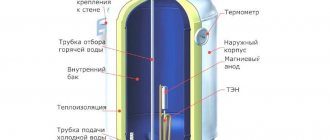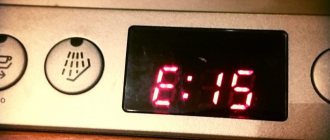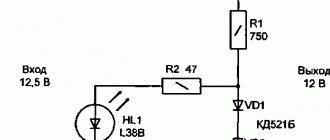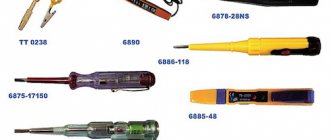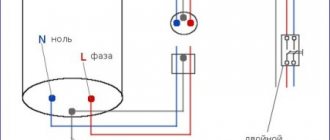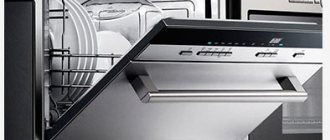Electric water heaters fail as often as other household appliances. This is due to poor water quality, damage to the electrical wiring, failure of the heating element, installation error or improper use of the equipment. Typical problems can be fixed on your own, without the involvement of specialists.
The lack of hot water negatively affects the usual way of life. If the water heater does not heat water and the light on it is on, you should worry about its speedy restoration.
If the listed elements do not work correctly (or fail), electric water heaters will not perform their main functions:
- Heating element - often fails due to prolonged use.
- The anode is a rod made of non-corrosive steel with a surface coating of magnesium. It attracts all the salts contained in the water. When actively using the water heater, it is recommended to replace the anode at least once a year .
- Thermostat is an internal element that controls water heating. In automatic mode, the element compares the current temperature with the user-set temperature and turns on/off the heating relay.
- Insulating gaskets are gaskets between the connecting elements of pipes and the water heater.
Determining the cause of the malfunction
Typical causes of malfunction of instantaneous water heaters and boilers include:
- poor water quality;
- error during installation of the device;
- damage to electrical wiring;
- improper operation.
Failure of the heating element is associated with the appearance of scale accumulating on the surface of the tank or due to a malfunction of the thermal protection button and safety valve.
Another common reason why a water heater does not heat water is a faulty electronic module of the device. It is strictly forbidden to replace it yourself , especially if the equipment is under warranty. Contact our specialist for qualified assistance.
To determine the cause of the malfunction, a careful visual inspection of the boiler is required. Be sure to pay attention to the light that lights up while the device is operating (when heating). If it doesn't light, try increasing the heating temperature. There may be 2 situations:
- The lamp (or indicator) lights up.
If the water heater does not heat water, but the indicator lights on the panel are on, this indicates a failure and the need to replace the heating element. You can verify this with a multimeter , which is connected to the device and adjusted to a certain resistance value. If you see zero on the indicator, the problem is a short circuit. You see the infinity symbol - there is an electrical break in the circuit.
It may also happen that when you turn on the device, the automation immediately turns it off. This is another indicator of failure of the tubular electric heater . Use a little trick to check! Fix the thermal protection button with your finger and turn on the water heater. If it starts to work, you can return it to its full state by removing the scale. At the same time, do not forget to check the condition of the anode.
- The lamp did not light up.
If there is no glow indicator on the display, you need to check with a tester whether voltage is supplied from the network to the thermostat . If voltage is passing to the thermostat, check the status of the input/output. If there is no data on the tester indicator, the heating element should be replaced.
Determining the cause
The root cause of water heater failure is rightfully considered to be unsatisfactory consumer water quality. As a result, scale forms on the outside of the heating element, and inside the tank, the walls are subject to corrosion.
In the future, such violations have the most serious consequences and lead to expensive repairs of the unit, with the involvement of specialists and the replacement of main components.
A fairly common reason is heating interruptions. Photo source: stock.adobe.com
In addition to the above, the boiler may not work due to incorrect connection to the electrical network, hot and cold water systems.
Therefore, in order to protect the system from such a failure, the water heater piping is carried out according to the diagram designated by the device manufacturer, so as not to mix up the connection pipes.
Sometimes it happens that the plug heats up when the water heater is running. This can happen if the contact group is poor or the power line is low-power.
An equally common failure is when the boiler does not heat the water and the light does not light, which also indicates problems in the power supply unit.
Poor water quality
Source water with a high content of hardness salts at high temperatures creates conditions for the rapid deposition of scale on the walls of the water heater and heating element. Dense growths do not conduct heat well, and the boiler does not heat the water. With this phenomenon, there is also a disruption in the process of heat removal from the heating element, which causes it to overheat.
In addition, poor quality of source water often causes a hydrogen sulfide odor in the hot water supply coming from the boiler. It may appear due to the chemical composition of the water or the presence of bacteria in the device’s container.
The operating time depends on the water. Photo source: arouraios.gr
The first option can be detected when disassembling the heater, if the destruction of the magnesium anode is determined. The sulfides contained in water, when reacting with magnesium, form hydrogen sulfide, which destroys the protective rod.
Poor water quality is especially dangerous for instantaneous water heaters that do not have sufficient volume and have a high-speed heating mode.
Modern flow-through devices have protection against overheating, and if the indicator light comes on due to high temperature, and the output water is slightly warm and has low pressure, then this may indicate large scale deposits inside the device.
Improper use of the device
In order for the water heater to function properly during the warranty period, you must follow several mandatory operating rules:
- There is no need to set the regulator to the maximum temperature mode for heating water, since the heating element can burn out very quickly, even in six months.
- If the boiler model has 2 separate heating elements and, accordingly, two connection keys, it is recommended that only one is constantly working. Thus, you can insure the heater against burnout of one of the heating elements.
- It is very important to promptly replace a faulty safety valve.
It is made of two parts that perform different functions. The first one protects the device from excess water pressure during the heating process, and the second one performs the function of a check valve.
This is necessary to preserve water in the boiler when its pressure in the water supply network is lower than in it. Both functions are important for safe operation of the heater.
Valve malfunction can be determined quite simply. If the first function is not performed, then when the water is heated, the expanding water will not come out through the valve, and in another case, on the contrary, when the pressure in the water supply network decreases, water will begin to leave the tank.
This will cause hot water to suddenly flow from a cold tap in the mixer, or the toilet tank will fill with it.
The heating element is faulty
A particularly common type of heating element failure, when the water heater does not heat the water, is a violation of the integrity of the nichrome thread in the heating coil.
This usually happens due to overheating of the heating element, covered with scale, or when it is put into operation in a tank in which there is no water. In addition, failure can be caused by poor quality of the tube filler when the spiral moves and touches the element body.
It is best to check the heating element using a tester or multimeter. Before replacing the element, first drain the liquid and dismantle the water heater. For testing, turn on the device in the state of measuring the least resistance and touch the terminals of the element with the probes of the meters.
If the spiral has a break, the device will demonstrate that the resistance in the circuit is equal to infinity, and the multimeter will steadily display one. If the spiral is not damaged, check its displacement. One probe of the multimeter touches an arbitrary terminal of the element, and the other touches the body of the heating element. For a serviceable element, the tester shows the resistance in the circuit equals infinity, and the multimeter shows one. Otherwise, the heating element is faulty and must be replaced.
Errors during the installation process
Installation must be followed exactly according to the manufacturer's recommendations. At the same time, it is important to carry out not only proper piping with the water supply system, but also an error-free connection to the electrical network.
For units with significant electrical power, it will be necessary to carry out individual wiring from the electrical panel to the input in the subscriber's house.
If you ignore this recommendation, very soon a problem will arise that will require not only repair of the device, but also replacement of all in-house electrical wiring, which simply cannot withstand high voltage.
The most common installation defect is ignoring the installation of the safety valve. In such a case, the device will experience high pressure, which will cause:
- dangerous damage to the storage tank;
- enamel delamination on the body and exposure of the protective layer of metal walls;
- displacement of the rubber gasket.
All such problems will lead to depressurization of the container and leakage of liquid from the tank.
The boiler does not heat the water, the lamp is on
If the indicator light is on and the water is not heating, the problem can be solved in 2 ways:
- Perhaps the temperature control knob is set to the minimum value and the water in the tank simply cannot warm up to the desired temperature. In this case, simply increase the minimum heating level (turn the knob clockwise).
- The thermostat may have turned on. If this happens, simply turn on the thermal protection button. Please note that on water heaters Thermex, Baxi, Ariston and others, the button may be located in different places on the body .
The water heater does not heat, the lamp does not light up
Another typical situation is that the boiler does not heat the water to the required temperature, and the indicator lamp does not light up. This indicates the following problems:
- presence of scale on the heating element;
- malfunction of the control board (electronic component);
- heating element malfunctions;
- failure of the safety valve.
To verify this, the water is completely drained from the tank and the device is disassembled. All internal electronic components should be checked using a multimeter, tester and voltage indicator. If you don’t have these devices at home or you don’t know how to use them, call a professional.
Common causes of water heater failure
The most common cause of boiler failure is scale deposits on internal parts.
The operation of the device is impaired if one of the following parts fails:
- Heating element - provides heating of the liquid in the tank;
- thermostat - measures the temperature of the liquid, turns the relay on and off when the specified high and low values are reached;
- batch switch - supplies voltage to the device, turns off the current supply when the system overheats and there is a short circuit on the line;
- anode - responsible for extracting salts from water, preventing the formation of sediment and plaque;
- electrical wiring with indicator - provides energy to the device parts.
When the boiler does not heat the water, the cause of this phenomenon may be:
- Failure of the heating element. This happens due to the depletion of the resource or the adhesion of limescale to the walls of the tubes. This leads to the fact that the heating element heats constantly, but the relay does not work. As a result, the product simply burns out. In such cases, the boiler does not heat the water and the light does not light up.
- Incorrect settings. During assembly, the thermostat was set to "0" or "off" and then the protective cap was connected. Given the flexibility of the plastic, this can be done without breaking the casing.
- Damage to wires. The products are powerful, over time the contacts oxidize and begin to get very hot until they burn out. A faulty electrical wiring is indicated by the lack of light on the indicator and cold water.
- Poor water quality. The result is the formation of a thick layer of porous fur around the heating element. In such a situation, limescale becomes a heat insulator, so the boiler does not heat the water completely.
- Pipeline clogged. Most often this happens at the joints of fittings, where there are protruding fragments. If there is no water in the tank, the relay does not allow the heater to turn on, since it immediately heats up to 100 degrees, which is the threshold for the safety device to operate.
- Wrong choice of cable, plug and socket. If the power of the equipment does not match, they become very hot, which is why the automation is triggered, interrupting the current supply.
Typical causes of malfunction of instantaneous water heaters and boilers include:
- poor water quality;
- error during installation of the device;
- damage to electrical wiring;
- improper operation.
Another common reason why a water heater does not heat water is a faulty electronic module of the device. It is strictly forbidden to replace it yourself, especially if the equipment is under warranty. Contact our specialist for qualified assistance.
To determine the cause of the malfunction, a careful visual inspection of the boiler is required.
Be sure to pay attention to the light that lights up while the device is operating (when heating). If it does not light, try increasing the heating temperature
There may be 2 situations:
- The lamp (or indicator) lights up.
If the water heater does not heat water, but the indicator lights on the panel are on, this indicates a failure and the need to replace the heating element. A multimeter, which is connected to the device and adjusted to a certain resistance value, will help you verify this. If you see zero on the indicator, the problem is a short circuit. You see the infinity symbol - there is an electrical break in the circuit.
If there is no glow indicator on the display, you need to check with a tester whether voltage is supplied from the network to the thermostat. If voltage is passing to the thermostat, check the status of the input/output. If there is no data on the tester indicator, the heating element should be replaced.
Boiler does not heat water well
Poor heating of water in a boiler in 90% of cases is caused by the condition of the heating element. The service life of this element is no more than 4 years. Over time, scale appears on its surface, reducing heat transfer. Sometimes an open circuit or short circuit occurs. This can only be determined with a multimeter. At the same time, be sure to pay attention to the condition of the thermostat !
The average boiler heating time is from 2 to 4 hours, depending on the volume of the tank. If it heats at half the set temperature, then there is a functional problem with the equipment.
Reasons and diagnostics why the water heater does not heat.
There can be several reasons for the boiler not working correctly - from damaged electrical wiring to a malfunction of the heating element.
To determine the cause of the breakdown, a thorough inspection of the water heater should be performed. So, first of all, you should pay attention to whether the light indicating the operation of the boiler is on. If the light does not light, you should use a tester to check whether 220 V is supplied to the “ends” of the thermostat .
If 220 V is supplied when the thermal protection button is turned on, you should disconnect the water heater from the network and remove the thermostat.
The part should be ringed at the input-output for phase and “line” 0, when checking, rotating the thermostat regulator. If the part does not turn on in phase or line 0, it should be replaced.
If the light is on, but the boiler does not heat the water, or heats it very weakly, then the reason is a breakdown of the heating element. In this case, it is necessary to drain the water from the water heater and replace the broken part.
The heating element can break for two reasons:
- due to the formation of a large amount of scale on its surface and the thermal protection button not working;
- due to lack of water in the heater due to a faulty safety valve.
A common reason that the heater does not heat water is a malfunction of the electronic module. It is not recommended to repair or replace such a part yourself. Also, the cause of such a breakdown may be the activation of emergency cut-off devices.
Troubleshooting
Replacing the heating element
Replacing heating elements for water heaters Ariston, Electrolux, Termex and others is similar, despite the design differences and different appearance of the devices. For work you will need:
- wrenches (with socket heads);
- pliers;
- positive and negative screwdrivers;
- screwdriver with voltage indicator.
The sequence of actions is as follows:
- Close the water in the riser and drain the water inside the boiler.
- Disconnect the power supply to the electrical appliance.
- Remove the decorative cover that provides access to the electronic components and check that there is no voltage with an indicator screwdriver.
- Remove the terminals and disconnect the wires (be sure to remember the connection diagram). It would be a good idea to take a photo of the connection diagram.
Do not allow moisture to come into contact with the terminals, contacts and electronic board of the device to avoid short circuits and failure.
- After removing the cover and disconnecting the wires, remove the heating element.
- Check its condition, clean the anode from deposits.
Installing a new element is carried out in the reverse order, while remembering your own safety rules to avoid electric shock .
Replacing the thermostat
To replace the thermostat, follow these steps:
- Remove the fixing ring (clamping) near the heating element.
- Remove the sensor adjustment unit and the thermostat itself.
- Install a new element.
- Secure it with a clamping ring.
- Check the condition (position) of the safety valve.
Please note that after replacing the thermostat, it is not recommended to immediately start operating the device! Check that cold water is flowing correctly inside, check that the connecting element does not hiss. The hot tap is then opened to release any air that has accumulated inside the boiler. Only after this can a test run be carried out .
The plug gets hot when the water heater is running
Heating of the fork (slight) is allowed during operation. But if it gets too hot, you need to:
- Visually check the condition of the tees and extension cords to which the device is connected. Try to choose an extension cord with a large cross-section of wire for fire safety purposes .
- Check the condition of the outlet to ensure that the water heater plug fits tightly into the sockets. In some cases, when a plug or socket is loose, the adjacent part of the wire may become hot.
An incorrectly selected extension cord can cause a fire in a house or apartment, since water heaters are powerful and energy-intensive devices (1.2-2.6 kW).
Instantaneous water heater does not heat water
In terms of quantity, suppliers sell instantaneous water heaters by an order of magnitude less than electric storage heaters. This is due to increased energy consumption. Typical reasons why instantaneous water heaters do not heat water:
- Faulty spiral . The best option is to replace the element. Winding nichrome thread will help solve the problem for just a few days. This increases the fire hazard.
Low water pressure . The water sensor does not send a heating signal to the coil through the electronic unit. A common problem with devices.
Radiator clogged . Disconnect the device from the electrical outlet and disassemble it. If the radiator is very clogged, you should place it in a lemon solution for several hours.
If you plan to not turn on the water heater for a long time (for example, while you are away from home for a long time), try to completely drain the water from the tank and hoses. This will eliminate the likelihood of scale and deposits appearing on the surface, and will also increase the service life of the device. When turned on, self-diagnostic devices will help check the condition and readiness for operation (error codes E2, E3 are shown or all indicators are flashing).
The boiler does not heat the water well, what is the reason?
Often
instantaneous water heaters and boilers stop working or work incorrectly for the following reasons:
- water of poor quality;
— errors made during installation;
— wiring damage;
- incorrect operation.
REFERENCE! Typically, breakdowns of the heating element occur due to deposits of scale on the surface in large quantities, breakdowns of the thermal protection button, as well as a non-functioning safety valve, due to which the water supply is interrupted.
Also, quite often the heater is not able to heat water due to breakdowns of the electronic module. It is not recommended to change the module yourself. For this it is better to contact specialists.
To accurately determine the cause, you should carefully inspect the device. First you need to check the operation of the light bulb, which should be lit while heating the water. To do this, you need to set a higher temperature.
After this there are two options:
- The lamp came on
If the indicator lights are on, but the water heater does not heat the water, then the heating element is broken. To find the cause, you will need a multimeter configured to detect resistance, which must be connected to the device. If the indicator displays zero, then the fault is a short circuit; if infinity, then it is a break.
Also, the need to replace the heating element is indicated by the activation of the automation, which immediately after turning on the device turns it off. This should tell you that the tubular electric heater has burned out.
Finding out exactly what the problem is is quite simple. When the device is turned off, the thermal protection button is retracted, after which the device turns on. If the heater starts working, then the heating element should be descaled or replaced with a new one.
REFERENCE! Lime deposits appear on the surface of the heating element due to breakdowns of the anode. Therefore, when replacing the heating element, you need to make sure that the magnesium rod is working.
- The lamp did not light up
Then you will need a tester that will help determine whether there is a voltage of 220V to the thermostat. To do this, you need to connect a tester to the heating element with the thermal protection running.
If there is voltage, then you need to turn off the device, remove the thermostat and ring the input-output by turning the thermostat. If the device does not operate when the line and phase are zero, then it needs to be replaced.
The lamp is on, the boiler does not heat the water
If the water does not heat up and the lamp is on, then there are two options to solve this problem:
- Maybe the knob is set to the minimum position, so the water is not heated at the desired temperature. In this case, you need to turn the handle in a clockwise direction.
- The thermostat may be on. Then you need to turn on the thermal protection button, which is located on the case (in different places for different models).
Review of reasons
The water doesn't heat up, the lamp doesn't light up
There are situations when the boiler does not heat the water to the required temperature and the lamp does not light. If the indication is completely disabled, then there are several options:
- breakdown of the heating element;
— a large amount of scale on the heating element;
— failure of the electronic board;
— breakage of the safety valve.
REFERENCE! In case of possible malfunctions, you need to remove the water and disassemble the boiler. All parts must be carefully checked using a multimeter, tester, voltage indicator.
The boiler began to heat water poorly
The most common reason why the boiler does not heat the water to the required temperature or heats it very slowly is the operation of the heating element.
This problem occurs especially often in older models of electric and gas appliances. The operating period of such a heating element is approximately 4 years. If the device is used for a long time, a large amount of deposits accumulates on it, which reduces heat transfer. In this case, a short circuit or break may occur, which can be determined using a multimeter. If the part burns out completely, you will have to buy and install a new heating element.
REFERENCE! In addition, the boiler may not work properly due to a broken thermostat, which will also have to be replaced.
Methods for troubleshooting
Replacing the heating element
Although different models of water heating devices have different designs and appearance, the process of replacing their heating elements is the same.
To do this you will need the following tools:
- pliers;
- Phillips and flathead screwdrivers;
— screwdriver indicator;
- spanners.
To replace the heating element, you need to do the following:
- Shut off the water supply to the water heater at the riser. The hot water tap also needs to be closed.
- Remove all water.
- Disconnect the boiler from the network.
- Remove the cover and use an indicator screwdriver to make sure there is no voltage at the terminals. Remove wall models and place them on the floor.
- Remove the nuts and disconnect the wires. In this case, you need to remember the connection order so that during assembly you can put everything in place without problems.
REFERENCE! During replacement, you need to pay attention to ensure that moisture does not get on the contacts.
Often, along with the heating element, it is necessary to change the anode, which protects it from deposits. In addition, you need to inspect the gaskets located between the heating element and the tank.
The new heating element must be installed in the reverse order. Before connecting the device to the network, it must be checked for leaks.
Cleaning the water heater heating element from scale
To clean the heating element from scale, you will need a solution of citric acid, which is prepared from 1 liter of water and 50 grams of acid. The volume of the solution must be such that the heating element fits completely there.
The heating element needs to be kept in this solution for a few days, and then carefully remove any remaining dirt and scale using a stiff brush.
Replacing the thermostat
This happens in the following last:
— you need to remove the pressure ring located near the heating element;
— now you need to remove the thermostat sensors and the control unit;
— Install a new thermostat and pressure ring;
— assemble the water heater.
The device cannot be used immediately after replacing its thermostat. Initially, you should make sure that cold water is flowing, inspect all connections for possible leaks and bleed the air by opening the hot tap. Only after these steps can the device be connected to the electrical network and perform a test run, gradually increasing the heating temperature.
